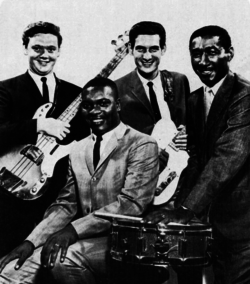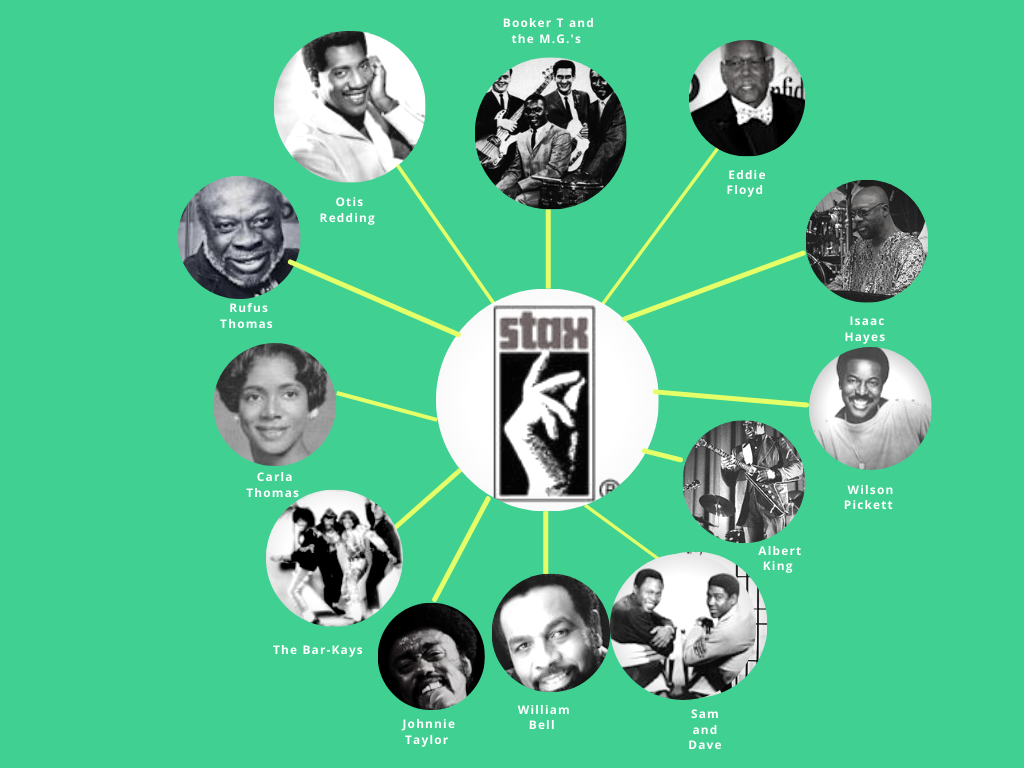
This week’s Musical Tree is a little different! Instead of focusing on a particular artist, this week I am highlighting a music studio out of Memphis, Tennessee that produced some of the greatest soul and R&B music ever recorded. This is the story of Stax Records.
The 1950’s was an exciting time for music in Memphis. Sun Records, owned by former undertaker Sam Phillips, had established itself with a young artist named Elvis Presley. A local banker by day and country fiddler by night, Jim Stewart loved music and dreamed of making it big as a musician. However, deep down he knew that he didn’t have the talent to make it as a performer so, after seeing the success of Sun Records, he decided how hard could it be? So, in 1957 Jim Stewart formed his own recording studio called Satellite Records. Not only would he be the studio owner, but he would also be the music producer and engineer, despite having no training or knowledge in either of these areas.

Satellite Records released their first song in October of 1957 called ‘Blue Roses’. The song suffered from inferior sound quality. After struggling for a few years Jim Stewart approached his sister, Estelle Axton, who was also a music lover and she agreed to mortgage her house in order to finance the purchase of an Ampex 350 console recorder. Later she refinanced her house again to help fund the studio’s move to an abandoned movie theater on McLemore Avenue in Memphis. The studio was renamed to Stax, the first two letters of Stewart and Axton’s last name. Stax Records was open for business!
Short on cash, Jim and Estelle converted the concession area to a record store called the Satellite Record Shop. Estelle ran the record shop, which gave her the opportunity to listen to what records were popular and in turn helped influence the music produced at Stax. Estelle was regarded as a mother figure at the company. While she had no formal training in music or marketing, she had an uncanny instinct for music and made many valuable suggestions to the young writers and musicians at Stax. Booker T. Jones described her as an “inspirer”, saying “She just loved music, loved people. She was always bringing us up there (the record shop), having us listen to records. She kept us in touch with the music industry. I doubt there would have been a Stax Records without Estelle Axton. She encouraged the entire Stax roster from her little perch behind the counter”.

Stax was unique in their approach to producing music in a number of ways.
They employed a house band. Booker T. and the M.G.’s was an instrumental group that would record numerous hit singles on their own, including the 1962 smash ‘Green Onions’.
Guitarist Steve Cropper headed the original house band, but by 1962 keyboard player Booker T. Jones – who grew up 2 blocks from the studio – became a regular session musician at Stax and the band was born. Two years later Donald “Duck” Dunn joined the band and the classic lineup was set, joining Cropper, Jones, and drummer Al Jackson Jr. I think it is so cool that all four musicians were from Memphis and would play on almost every record recorded at Stax between 1963 and 1969!

Great songwriting was another component at Stax, and a number of hit songs written during this period were written by Dave Porter and Isaac Hayes. Hayes, who would achieve world-wide fame with his hit song ‘Shaft’, was a key member of the studio songwriting team. The two wrote many of the hits by Sam and Dave, including ‘Soul Man’ and ‘Hold On I’m Coming’
How musicians at Stax approached recording was also unique for its time. Most studios were unionized shops, with workers assigned strict roles with set hours. Music was generally written out, so each player knew their part. Not at Stax. Artists and musicians would flow freely between the control room, still manned by Jim Stewart, and the recording studio. Very rarely were songs worked out in advance. The sessions would run as long as needed. Musicians were encouraged to make suggestions and often did as songs came together. Once the finished product was agreed upon, the final version would often be captured live in only one or two takes. It was truly a unique recording experience that produced some of the best R&B and Soul music ever recorded. The final component of the unique Stax sound were The Memphis Horns. Called “arguably the greatest soul horn section ever”, they played on almost every Stax song that included horns. Originally a sextet, they gradually slimmed down to a duo – Wayne Jackson on trumpet and Andrew Love on tenor saxophone. The Memphis Horns helped define the Stax sound and made the listener aware that they were listening to a Stax record. When The Beatles were recording the album ‘Revolver’, they wanted to use the Memphis Horns on a couple of tracks. They were all set to fly to Memphis to record at Stax under secrecy. Days before the scheduled session word leaked out and a local Memphis paper reported that the Beatles were coming to Memphis! Infuriated, Beatles manager Brian Epstein canceled the session and alas, it was not to be.

Perhaps the most unique aspect of Stax records was that during this entire time—the turbulent 1960’s—black and white musicians and staff worked side by side. The studio was fully integrated without ever intending to be in a city that was segregated at that time. Musicians and staff, reflecting back said that this never occurred to anyone. It was their love of music that inspired them to work alongside each other, never even considering the differences in race. Quite remarkable given all that was happening in the US at the time. Yet another example of the power of music!
In 15 years Stax placed more than 167 hit songs in the Top 100 on the pop charts and an incredible 243 hits in the Top 100 of the R&B charts. Below is just a partial list of the artists that recorded and had success at Stax records.
- Booker T and the M.G.’s
- Rufus Thomas
- Otis Redding
- Carla Thomas
- Sam and Dave
- Eddie Floyd
- Johnnie Taylor
- William Bell
- The Bar-Kays
- Albert King
- Wilson Pickett
- Isaac Hayes
After 1968, Stax had limited success and ultimately the studio closed and filed for bankruptcy in 1975. There were three events that directly led to the studio’s decline.
First, in 1967 Atlantic Records was sold to CBS Records. Back in the early 1960’s Jim Stewart had signed a deal with Atlantic to distribute Stax’s records. After Atlantic Records was sold, he went to strike a deal with CBS Records. Not only was he unable to strike a deal, he learned that he had inadvertently signed away the rights to all of Stax’s songs recorded between 1962 and 1967 when he had signed the original deal with Atlantic Records. All of those royalties would no longer flow to Stax.
The second event was the death of Otis Redding in December of 1967. Otis was by far the biggest performer on the Stax label. In December of 1967, after having just finished recording ‘Sittin On The Dock of the Bay’, he left to do a mini tour in the Midwest. Tragically his plane crashed approaching Madison, Wisconsin, killing all but one of the passengers on board. Suddenly Stax was without the biggest artist on their roster. Otis Redding’s death devastated the studio.
The final blow to Stax happened on April 4, 1968 when Dr. Martin Luther King was assassinated at the Lorraine Motel in Memphis. The Lorraine Motel had a restaurant that a lot of the artists at Stax would frequent for lunch. Many songs were written at the hotel and bonds were forged there. After Dr. King’s assassination things were never the same at Stax. Where before race was never an issue, suddenly it was noticeable. Both black and white artists felt it. While they continued to work together, the musical bonds that had once been colorblind now were laid bare.
As ‘Sittin on the Dock of the Bay’ became the biggest hit ever released on the Stax label in 1968, sadly the wheels were already in motion that would ultimately lead to the neighborhood studio at 926 E. McLemore Avenue shutting down. A special era in American music, and music overall, would ultimately come to an end.
Today the Stax Museum stands on the exact spot where the studio once was. I encourage everyone to stop by for a visit to learn more about the extraordinary music that was created there.
I hope you enjoyed this week’s Musical Tree. Feel free to leave suggestions for future articles in the comments. Don’t forget to subscribe to be notified via email when there is a new post.
And you can now follow Tekesmusings.com on your social media of choice by clicking on the links at the bottom of the page! Until then, follow your passion, stay happy, and be thankful for whatever inspires you.


“….inadvertently signed away the rights to all of Stax’s songs…”
OUCH!!!
Great musing and so informative. Thanks for broadening my understanding and appreciation!
Pingback: The Bar-Kays – Teke's Musings
Pingback: Layla – Teke's Musings
Pingback: Cannon’s Jug Stompers – Teke's Musings
Pingback: Ian Hunter – Teke's Musings
Pingback: Jimmy Webb – Teke's Musings